Climate Variability and Change in Bihar, India: Challenges and Opportunities for Sustainable Crop Production
Abstract
:1. Introduction
2. Methodology
2.1. Description of Study Area
2.2. Data Source and Quality Control
2.2.1. Historical Climate Data
2.2.2. Future Climate Data
2.3. Data Analysis
2.3.1. Annual and Seasonal Analysis
2.3.2. Trend Analysis
2.4. Presentation of Data
3. Results
3.1. Changes in Annual and Seasonal Rainfall Amounts
3.2. Changes in Daily Rainfall Intensity
3.3. Annual and Seasonal Minimum Temperature Changes
3.4. Annual and Seasonal Maximum Temperature Changes
3.5. Trend of Annual Mean Minimum and Maximum Temperatures
3.6. Model Uncertainty in Rainfall and Temperature Projections
3.7. Annual and Seasonal Reference Evapotranspiration Changes
3.8. Changes in Monsoon Rainfall Onset and Cessation and Length of Growing Period
4. Discussion
4.1. Rainfall Changes and Its Implications for Crop Production
4.2. Temperature Changes and Implications for Crop Production
4.3. Monsoon Growing Season Changes and Implications for Crop Production
5. Conclusions
Supplementary Materials
Supplementary File 1Acknowledgments
Author Contributions
Conflicts of Interest
References
- Ahmed, M.; Suphachalasai, S. Assessing the Costs of Climate Change and Adaptation in South Asia; Asian Development Bank: Mandaluyong, Philippines, 2014. [Google Scholar]
- Knox, J.; Hess, T.; Daccache, A.; Wheeler, T. Climate change impacts on crop productivity in Africa and South Asia. Environ. Res. Lett. 2012, 7, 034032. [Google Scholar] [CrossRef]
- Niang, I.; Ruppel, O.C.; Abdrabo, M.A.; Essel, A.; Lennard, C.; Padgham, J.; Urquhart, P. Africa. In Climate Change 2014: Impacts, Adaptation, and Vulnerability. Part B: Regional Aspects; Contribution of Working Group II to the Fifth Assessment Report of the Intergovernmental Panel on Climate Change; Barros, V.R., Field, C.B., Dokken, D.J., Mastrandera, M.D., Eds.; Cambridge University Press: Cambridge, UK; New York, NY, USA, 2014. [Google Scholar]
- Porter, J.R.; Xie, L.; Challinor, A.J.; Cochrane, K.; Howden, S.M.; Iqbal, M.M.; Lobell, D.B.; Travasso, M.I. Food Security and Food Production Systems. In Climate Change 2014: Impacts, Adaptation, and Vulnerability. Part A: Global and Sectoral Aspects; Contribution of Working Group II to the Fifth Assessment Report of the Intergovernmental Panel on Climate Change; Mastrandrea, P.R., White, L.L., Eds.; Cambridge University Press: Cambridge, UK; New York, NY, USA, 2014. [Google Scholar]
- Chattopadhyay, N. Climate change and food security in India. In Climate Change and Food Security in South Asia; Lal, R., Sivakumar, M.V.K., Faiz, M.A., Rahman, A.H.M.M., Islam, K.R., Eds.; Springe: Berlin, Germany, 2011; pp. 129–251. [Google Scholar]
- Lobell, D.B.; Schlenker, W.; Costa-Roberts, J. Climate trends and global crop production since 1980. Science 2011, 333, 616–620. [Google Scholar] [CrossRef] [PubMed]
- Cairns, J.E.; Sonder, K.; Zaidi, P.H.; Verhulst, N.; Mahuku, G.; Babu, R.; Nair, S.K.; Das, B.; Govaerts, B.; Vinayan, M.T.; et al. Maize production in a changing climate: Impacts, adaptation, and mitigation strategies. Adv. Agron. 2012, 114, 1–57. [Google Scholar] [CrossRef]
- Hijioka, Y.; Lin, E.; Pereira, J.J.; Corlett, R.T.; Cui, X.; Insarov, G.; Lasco, R.; Lindgren, E. Akhilesh Surjan Asia. In Climate Change 2014: Impacts, Adaptation, and Vulnerability. Part B: Regional Aspects; Contribution of Working Group II to the Fifth Assessment Report of the Intergovernmental Panel on Climate Change; Barros, V.R., Field, C.B., Dokken, D.J., Mastrandrea, M.D., Mach, K.J., Bilir, T.E., Chatterjee, M., Ebi, K.L., Estrada, Y.O., Genova, R.C., et al., Eds.; Cambridge University Press: Cambridge, UK; New York, NY, USA, 2014; pp. 1327–1370. [Google Scholar]
- Randhawa, R.K.; Singh, H.; Kang, M.S. Global warming and its possible impact on agriculture in India. Adv. Agron. 2014, 123, 65–121. [Google Scholar] [CrossRef]
- Rupakumar, K.; Kumar, K.K.; Pant, G.B.; Srinivisan, G. Climate change: The Indian scenario. In International Conference on Science and Technology Capacity Building for Climate Change; Background Paper Prepared by FICCI; FICCI: New Delhi, India, 2002; pp. 5–17. [Google Scholar]
- Roy, S.S.; Balling, R.C. Analysis of trends in maximum and minimum temperature, diurnal temperature range, and cloud cover over India. Geophys. Res. Lett. 2005, 32, 2–5. [Google Scholar] [CrossRef]
- Lal, M.; Nozawa, T.; Emori, S.; Harasawa, H.; Takahashi, K.; Kimoto, M.; Nakajima, T.; Takemura, T.; Numaguti, A. Future climate change: Implications for Indian summer monsoon and its variability. Curr. Sci. 2001, 81, 1196–1207. [Google Scholar]
- Prabhakar, S.V.R.K.; Shaw, R. Climate change adaptation implications for drought risk mitigation: A perspective for India. Clim. Chang. 2008, 88, 113–130. [Google Scholar] [CrossRef]
- Dagar, J.C.; Singh, A.K.; Singh, R.; Arunachalum, A.A. Climate change vis-a-vis Indian agriculture. Ann. Agric. Res. New Ser. 2012, 33, 189–203. [Google Scholar]
- Trajkovic, S.; Kolakovic, S. Wind-adjusted Turc equation for estimating reference evapotranspiration at humid European locations. Hydrol. Res. 2009, 40, 45–52. [Google Scholar]
- Hadgu, G.; Tesfaye, K.; Mamo, G. Analysis of climate change in Northern Ethiopia: Implications for agricultural production. Theor. Appl. Climatol. 2014, 117, 733–747. [Google Scholar] [CrossRef]
- Lal, M. Implications of climate change in sustained agricultural productivity in South Asia. Reg. Environ. Chang. 2011, 11, 79–94. [Google Scholar] [CrossRef]
- Pope, V. Why Are Climate Data and Evidence Important? Available online: http://blogs.worldbank.org/climatechange/why-are-climate-data-and-evidence-important (accessed on 14 January 2016).
- GOB State Action Plan on Climate Change: Building Resilience through Development. Available online: http://www.moef.gov.in/sites/default/files/Bihar-State Action Plan on Climate Change (2).pdf (accessed on 7 January 2016).
- Mason, S.; Kruczkiewicz, A.; Ceccato, P.; Crawford, A. Accessing and Using Climate Data and Information in Fragile, Data-Poor States; International Institute for Sustainable Development: Winnipeg, MB, Canada, 2015. [Google Scholar]
- You, Q.; Kang, S.; Aguilar, E.; Yan, Y. Changes in daily climate extremes in the eastern and central Tibetan Plateau during 1961–2005. J. Geophys. Res. Atmos. 2008, 113, D07101. [Google Scholar] [CrossRef]
- Klein Tank, A.M.G.; Zwiers, F.W.; Zhang, X. Guidelines on Analysis of Extremes in a Changing Climate in Support of Informed Decisions for Adaptation; World Meteorological Organization (WMO): Geneva, Switzerland, 2009. [Google Scholar]
- Ruane, A.C.; Goldberg, R.; Chryssanthacopoulos, J. Climate forcing datasets for agricultural modeling: Merged products for gap-filling and historical climate series estimation. Agric. For. Meteorol. 2015, 200, 233–248. [Google Scholar] [CrossRef]
- Siddik, M.A.Z.; Rahman, M. Trend analysis of maximum, minimum, and average temperatures in Bangladesh: 1961–2008. Theor. Appl. Climatol. 2014, 116, 721–730. [Google Scholar] [CrossRef]
- IPCC. Climate Change 2014: Synthesis Report; Contribution of Working Groups I, II and III to the Fifth Assessment Report of the Intergovernmental Panel on Climate Change; CoreWritingTeam, Pachauri, R.K., Meyer, L.A., Eds.; IPCC: Geneva, Switzerland, 2014; ISBN 9789291691432. [Google Scholar]
- Sivakumar, M.V.K. Predicting rainy season potential from the onset of rains in Southern Sahelian and Sudanian climatic zones of West Africa. Agric. For. Meteorol. 1988, 42, 295–305. [Google Scholar] [CrossRef]
- R Core Team. R: A Language and Environment for Statistical Computing; R Foundation for Statistical Computing: Vienna, Austria, 2011; ISBN 3-900051-07-0. [Google Scholar]
- Hargreaves, G.H.; Samani, Z.A. Reference crop evapotranspiration from ambient air temperature. In The 1985 Winter Meeting of American Society of Agricultural Engineers; American Society of Agricultural Engineers: Chicago, IL, USA, 1985; pp. 1–12. [Google Scholar]
- Sen, P.K. Estimates of the regression coefficient based on Kendall’s Tau. J. Am. Stat. Assoc. 1968, 63, 1379–1389. [Google Scholar] [CrossRef]
- Kendall, M.G.; Gibbons, J.D. Rank Correlation Methods, 5th ed.; Arnold, E., Ed.; Oxford University Press: New York, NY, USA; London, UK, 1990. [Google Scholar]
- Salvi, K.; Kannan, S.; Ghosh, S. Statistical downscaling and bias correction for projections of Indian rainfall and temperature in climate change studies. In Proceedings of the 2011 International Conference on Environmental and Computer Science, Singapore, 16–18 September 2011; Volume 19, pp. 7–11. [Google Scholar]
- Maraun, D. Bias correction, quantile mapping, and downscaling: Revisiting the inflation issue. J. Clim. 2013, 26, 2137–2143. [Google Scholar] [CrossRef]
- Semenov, M.A.; Stratonovitch, P. Use of multi-model ensembles from global climate models for assessment of climate change impacts. Clim. Res. 2010, 41, 1–14. [Google Scholar] [CrossRef]
- Krishnamurti, T.N.; Kishtawal, C.M.; Zhang, Z.; LaRow, T.E.; Bachiochi, D.R.; Williford, C.E.; Gadgil, S.; Surendran, S. Multimodel ensemble forecasts for weather and seasonal climate. J. Clim. 2000, 13, 4196–4216. [Google Scholar] [CrossRef]
- Kumar, K.R.; Sahai, A.K.; Kumar, K.K.; Patwardhan, S.K.; Mishra, P.K.; Revadekar, J.V.; Kamala, K.; Pant, G.B. High-resolution climate change scenarios for India for the 21st century. Curr. Sci. 2006, 90, 334–345. [Google Scholar]
- Geethalakshmi, V.; Lakshmanan, A.; Rajalakshmi, D.; Jagannathan, R.; Sridhar, G.; Ramaraj, A.P.; Bhuvaneswari, K.; Gurusamy, L.; Anbhazhagan, R. Climate change impact assessment and adaptation strategies to sustain rice production in Cauvery basin of Tamil Nadu. Curr. Sci. 2011, 101, 342–347. [Google Scholar]
- Kaur, R. Climate change and its possible impacts on agriculture in India. Indian Farm. 2012, 62, 10–15. [Google Scholar]
- Sharma, V.K.; Thind, T.S.; Singh, P.P.; Mohan, C.; Arora, J.K.; Prem, R. Disease-weather relationships and forecasting of bacterial leaf blight of rice. Plant Dis. Res. 2007, 22, 52–56. [Google Scholar]
- Hundal, S.S. Global climate change vis-a-vis crop productivity. In Natural and Anthropogenic Disasters: Vulnerability, Preparedness and Mitigation; Jha, M.K., Ed.; Publishing Company and Springer: New Delhi, India, 2010; pp. 413–431. [Google Scholar]
- Alexander, L.V.; Zhang, X.; Peterson, T.C.; Caesar, J.; Gleason, B.; Klein Tank, A.M.G.; Haylock, M.; Collins, D.; Trewin, B.; Rahimzadeh, F.; et al. Global observed changes in daily climate extremes of temperature and precipitation. J. Geophys. Res. 2006, 111, D05109. [Google Scholar] [CrossRef]
- Easterling, D.R.; Horton, B.; Jones, P.D.; Peterson, T.C.; Karl, T.R.; Parker, D.E.; Salinger, M.J.; Razuvayev, V.; Plummer, N.; Jamason, P.; et al. Maximum and minimum temperature trends for the globe. Science 1997, 277, 364–367. [Google Scholar] [CrossRef]
- Harrison, L.; Michaelsen, J.; Funk, C.; Husak, G. Effects of temperature changes on maize production in Mozambique. Clim. Res. 2011, 46, 211–222. [Google Scholar] [CrossRef]
- Deb, P.; Shrestha, S.; Babel, M.S. Forecasting climate change impacts and evaluation of adaptation options for maize cropping in the hilly terrain of Himalayas: Sikkim, India. Theor. Appl. Climatol. 2014, 121, 649–667. [Google Scholar] [CrossRef]
- Anand, A.; Khetarpal, S. Impact of climate change on agricultural productivity. In Plant Biology and Biotechnology, Volume I: Plant Diversity, Organization, Function and Improvement; Bahadur, B., Rajam, M.V., Sahijram, L., Krishnamurthy, K.V., Eds.; Springer: New Delhi, India, 2015; Volume I, pp. 729–755. ISBN 9788132222866. [Google Scholar]
- Luo, Q. Temperature thresholds and crop production: A review. Clim. Chang. 2011, 109, 583–598. [Google Scholar] [CrossRef]
- Hundal, S.S. Climatic variability and its impact on cereal productivity in Indian Punjab. Curr. Sci. 2007, 92, 506–512. [Google Scholar]
- Peng, S.; Huang, J.; Sheehy, J.E.; Laza, R.C.; Visperas, R.M.; Zhong, X.; Centeno, G.S.; Khush, G.S.; Cassman, K.G. Rice yields decline with higher night temperature from global warming. Proc. Natl. Acad. Sci. USA 2004, 101, 9971–9975. [Google Scholar] [CrossRef] [PubMed]
- Aggarwal, P.K.; Kalra, N. Analyzing the limitations set by climatic factors, genotype, and water and nitrogen availability on productivity of wheat II. Climatically potential yields and management strategies. Field Crop. Res. 1994, 38, 93–103. [Google Scholar] [CrossRef]
- Aggarwal, P.K. Global Climate Change and Indian Agriculture. Case Study form ICAR Network Project; Indian Council of Agricultural Research: New Delhi, India, 2009. [Google Scholar]
- Mayer, L.I.; Rattalino Edreira, J.I.; Maddonni, G.A. Oil yield components of maize crops exposed to heat stress during early and late grain-filling stages. Crop Sci. 2014, 54, 2236–2250. [Google Scholar] [CrossRef]
- Rattalino Edreira, J.I.; Budakli Carpici, E.; Sammarro, D.; Otegui, M.E. Heat stress effects around flowering on kernel set of temperate and tropical maize hybrids. Field Crop. Res. 2011, 123, 62–73. [Google Scholar] [CrossRef]
- Rezaei, E.E.; Webber, H.; Gaiser, T.; Naab, J.; Ewert, F. Heat stress in cereals: Mechanisms and modelling. Eur. J. Agron. 2015, 64, 98–113. [Google Scholar] [CrossRef]
- Lobell, D.B.; Bänziger, M.; Magorokosho, C.; Vivek, B. Nonlinear heat effects on African maize as evidenced by historical yield trials. Nat. Clim. Chang. 2011, 1, 42–45. [Google Scholar] [CrossRef]
- Dar, W.D.; Gowda, C.L.L. Declining agricultural productivity and global food security. J. Crop Improv. 2013, 27, 242–254. [Google Scholar] [CrossRef]
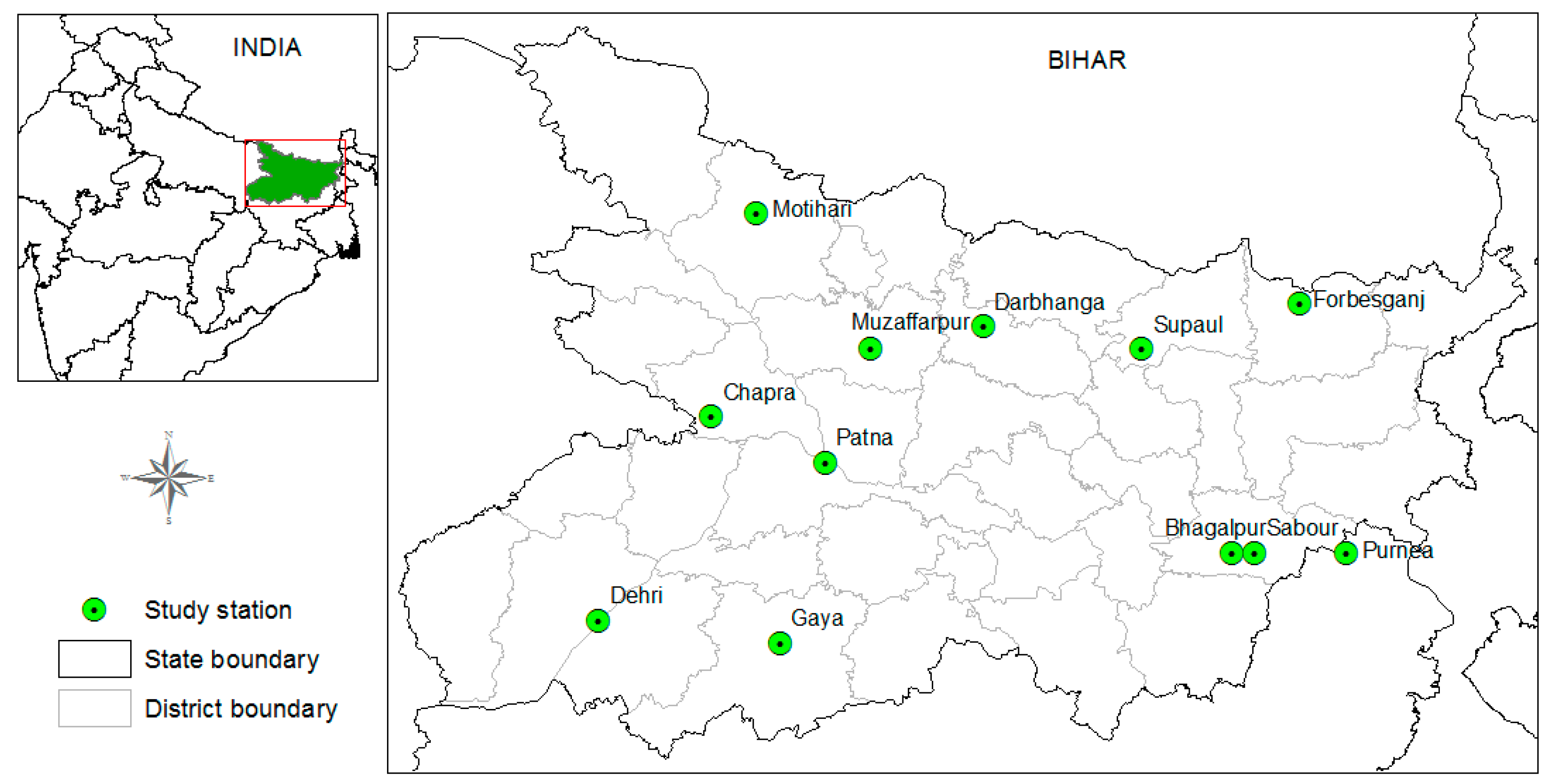
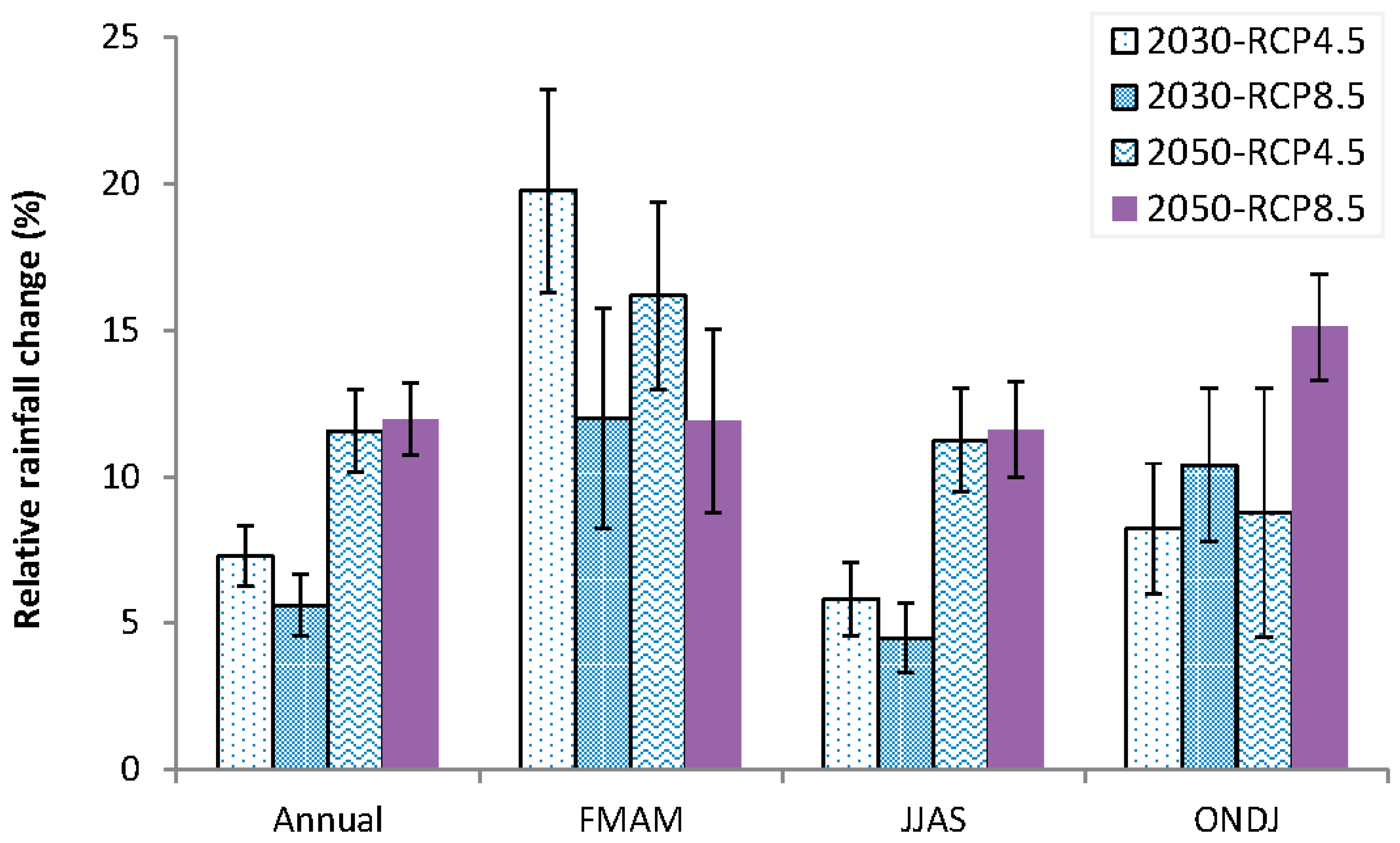
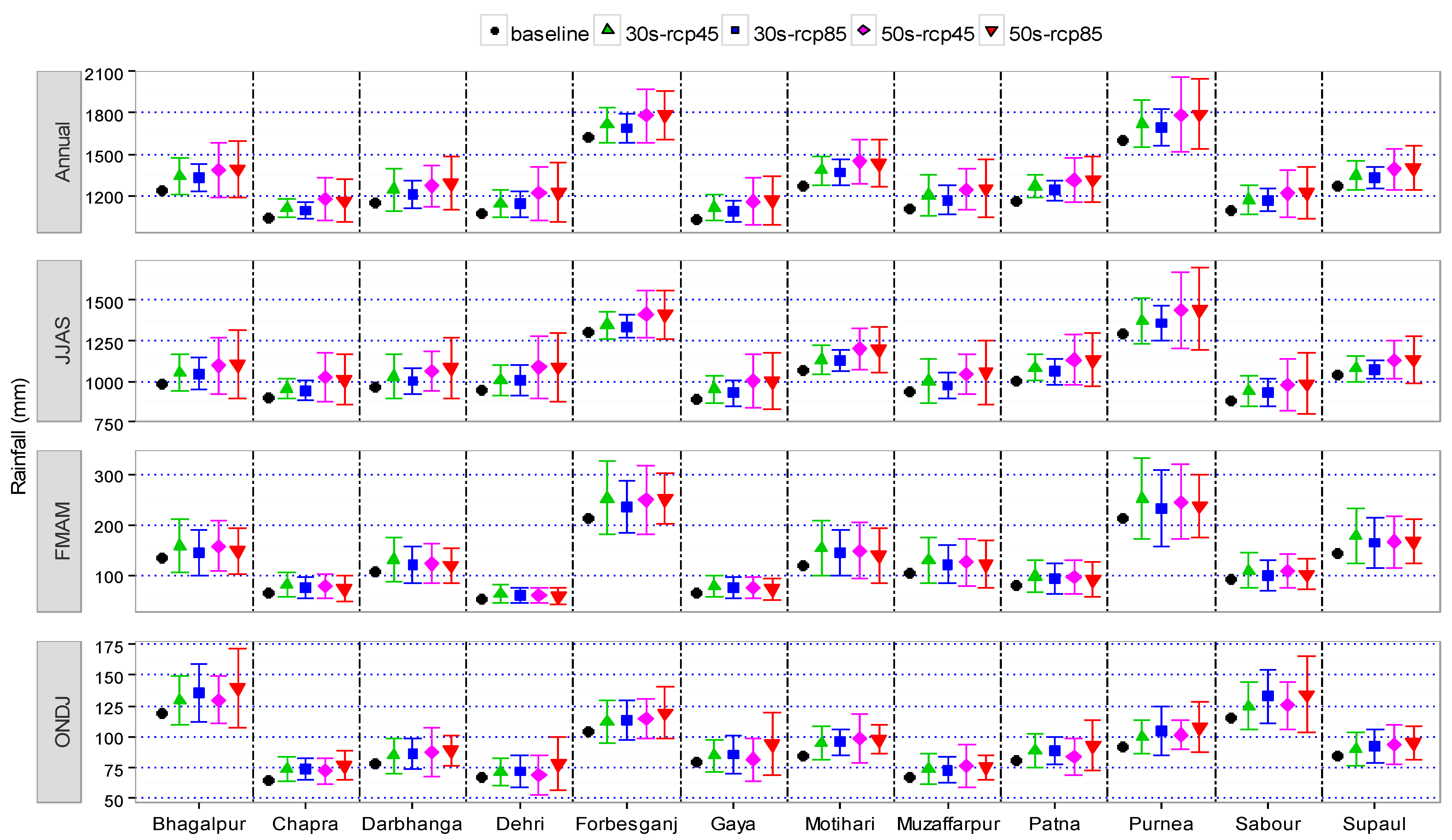
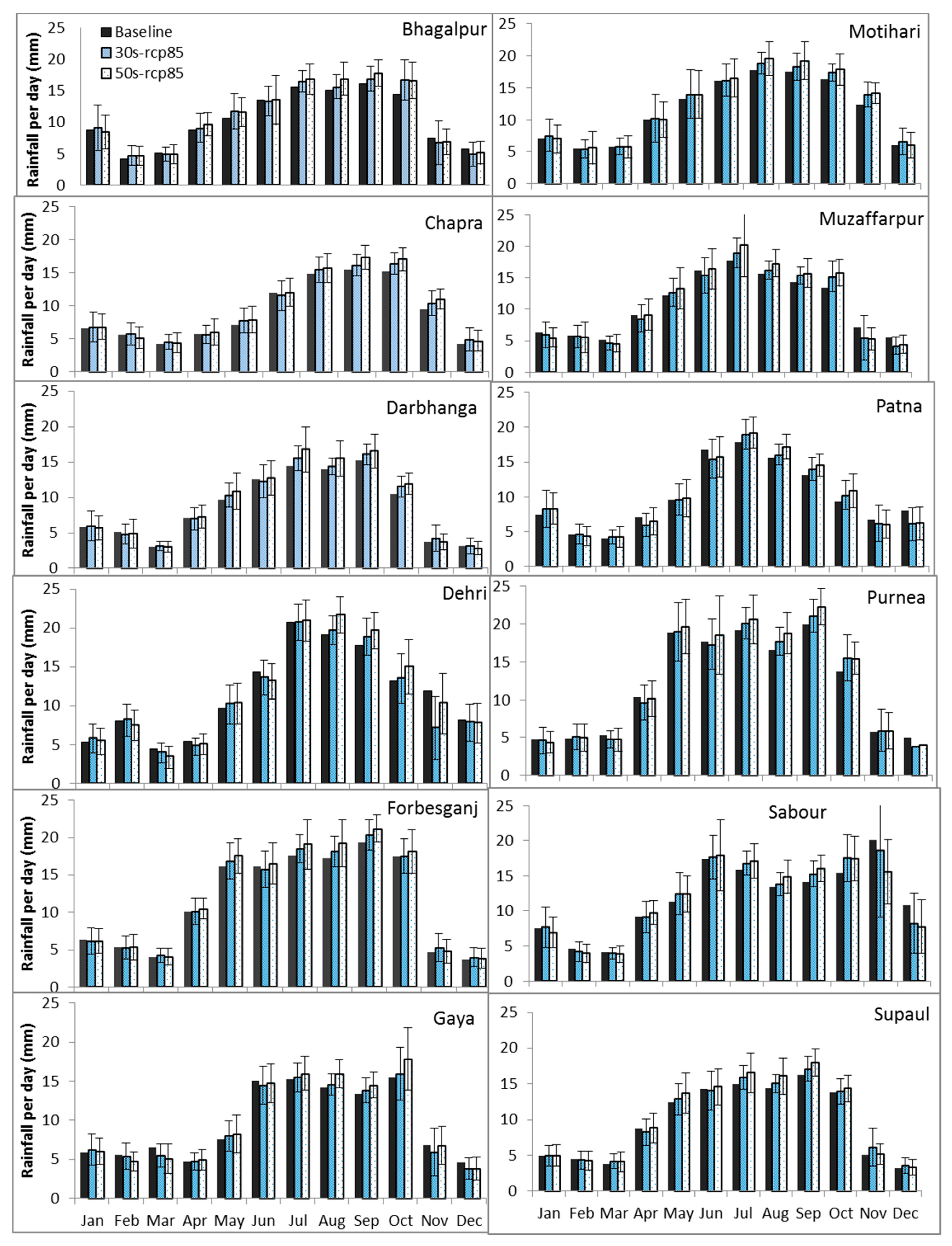

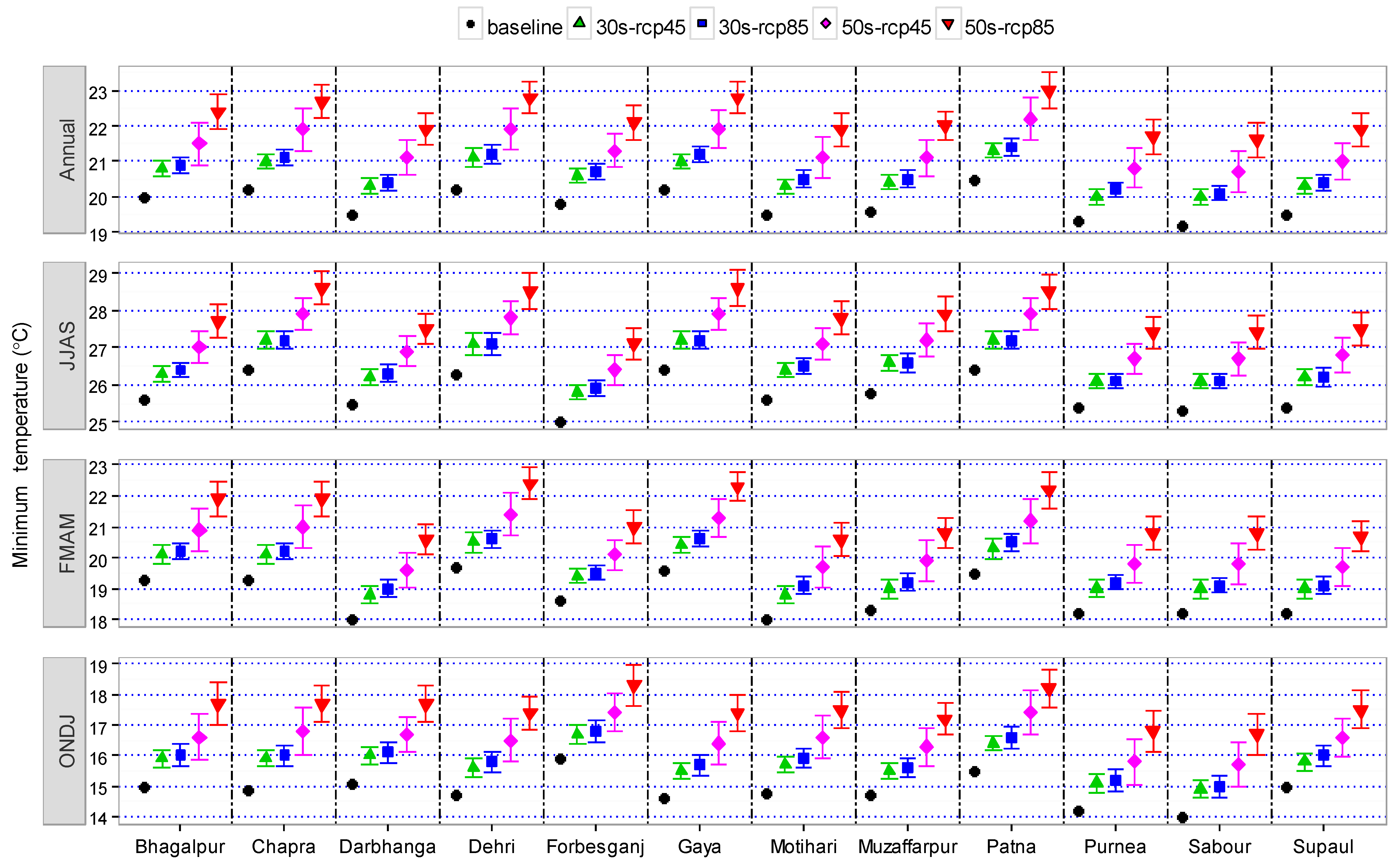
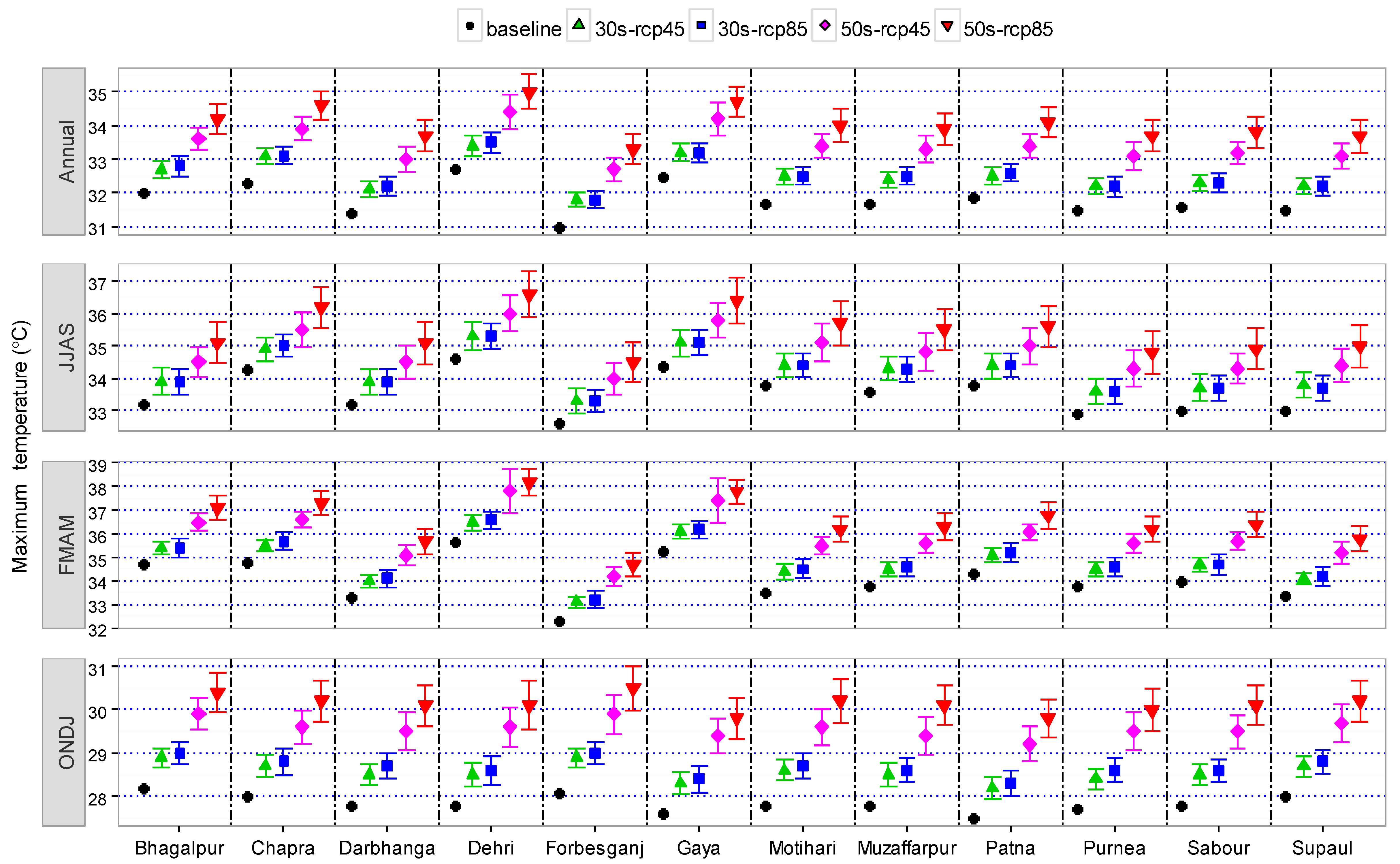

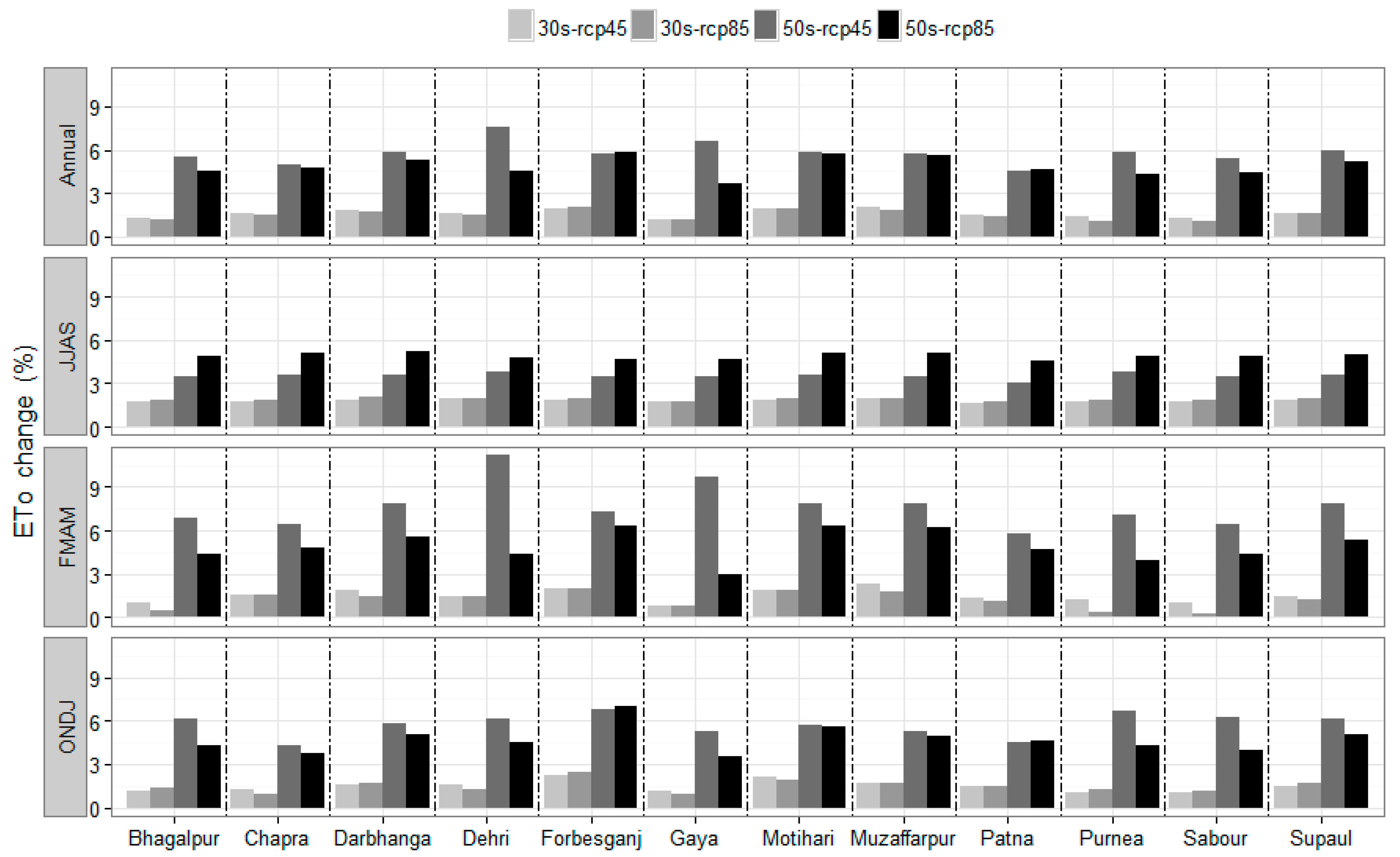
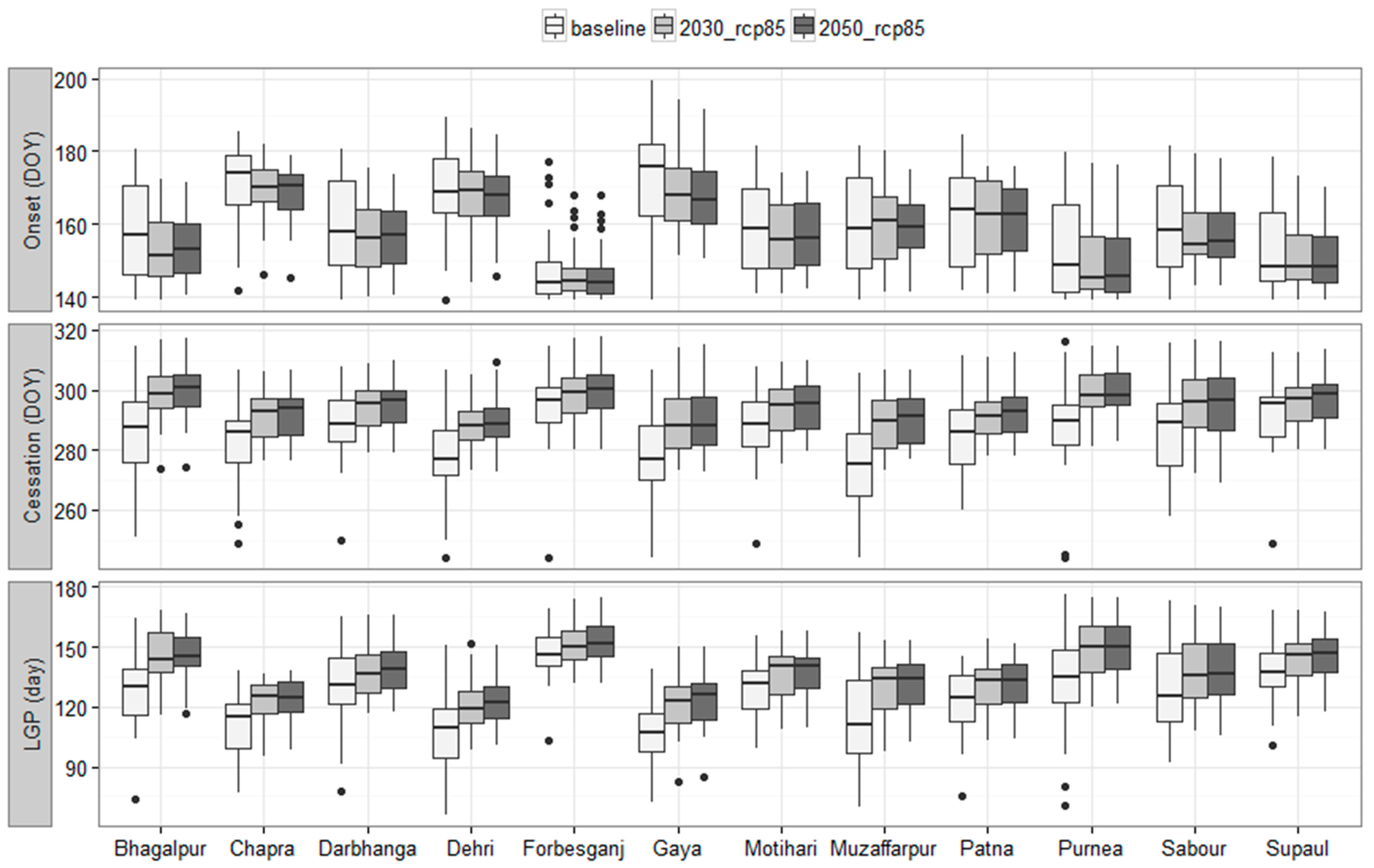
© 2017 by the authors. Licensee MDPI, Basel, Switzerland. This article is an open access article distributed under the terms and conditions of the Creative Commons Attribution (CC BY) license (http://creativecommons.org/licenses/by/4.0/).
Share and Cite
Tesfaye, K.; Aggarwal, P.K.; Mequanint, F.; Shirsath, P.B.; Stirling, C.M.; Khatri-Chhetri, A.; Rahut, D.B. Climate Variability and Change in Bihar, India: Challenges and Opportunities for Sustainable Crop Production. Sustainability 2017, 9, 1998. https://doi.org/10.3390/su9111998
Tesfaye K, Aggarwal PK, Mequanint F, Shirsath PB, Stirling CM, Khatri-Chhetri A, Rahut DB. Climate Variability and Change in Bihar, India: Challenges and Opportunities for Sustainable Crop Production. Sustainability. 2017; 9(11):1998. https://doi.org/10.3390/su9111998
Chicago/Turabian StyleTesfaye, Kindie, Pramod K. Aggarwal, Fasil Mequanint, Paresh B. Shirsath, Clare M. Stirling, Arun Khatri-Chhetri, and Dil Bahadur Rahut. 2017. "Climate Variability and Change in Bihar, India: Challenges and Opportunities for Sustainable Crop Production" Sustainability 9, no. 11: 1998. https://doi.org/10.3390/su9111998




